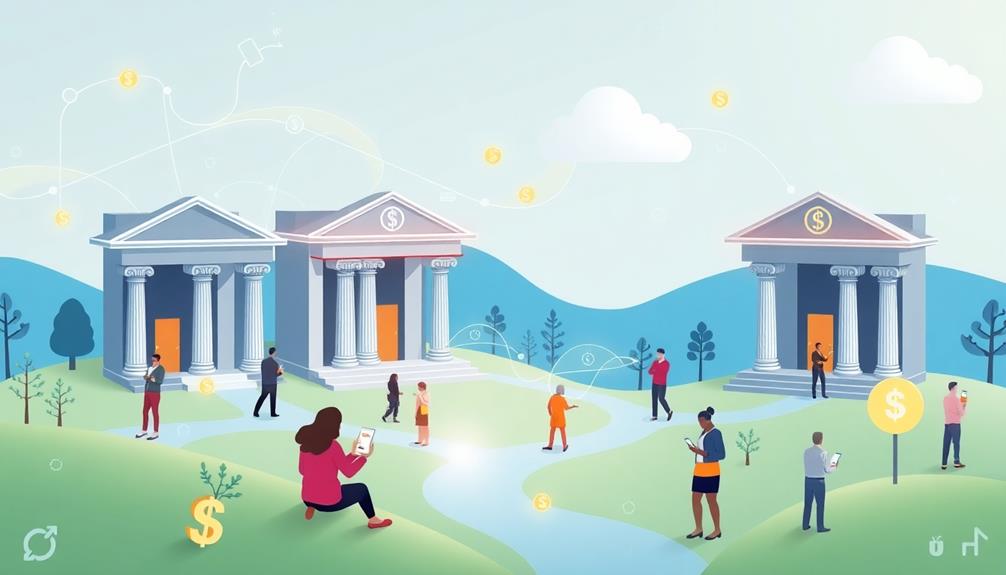IoT is changing payment processing by making transactions faster and more secure. You'll find smart devices, like NFC-enabled wearables, allowing for quick, contactless payments, enhancing convenience. Retailers utilize IoT-powered systems for real-time inventory management and personalized offers, which keep you engaged. Biometric authentication methods, like fingerprint scanning, further boost security and reduce fraud risks. With the IoT payment market projected to hit $2 trillion by 2025, it's clear that this technology is reshaping the landscape. Discover how these advancements can benefit you and your shopping experience in the evolving payment ecosystem.
Key Takeaways
- IoT enables contactless payments through NFC technology, enhancing transaction speed and convenience for consumers.
- Smart POS systems streamline payment processes and provide real-time inventory management in retail environments.
- Biometric authentication methods improve security in payment systems, reducing fraud risks significantly.
- Data analytics driven by IoT enhances personalized marketing strategies, improving customer engagement and satisfaction.
- The integration of AI and machine learning in IoT payment systems enhances fraud detection and overall transaction security.
The Impact of IoT on Payments

The rise of smart devices is transforming the way we handle payments, making transactions faster and more seamless than ever. With IoT-enabled payment solutions, you're experiencing a significant shift towards hassle-free transactions.
The integration of contactless payments through NFC technology means you can tap your device and complete a purchase in seconds, a feature that gained traction during the COVID-19 pandemic. Additionally, as credit card debt in the U.S. exceeded $930 billion in 2020, consumers are increasingly looking for more efficient ways to manage their finances and payments, including credit card insights.
Moreover, smart point-of-sale (POS) systems powered by IoT offer real-time inventory management and personalized offers, enhancing your shopping experience. These systems not only streamline operations for businesses but also keep you engaged with tailor-made promotions.
Security's also on the rise with biometric authentication methods, like facial recognition and fingerprint scanning. These technologies help reduce fraud risks and boost your confidence in digital transactions.
Imagine making a payment with just a glance at your smartwatch or fitness tracker; that's the convenience IoT brings to the table. As the market for IoT payment solutions is projected to reach $2 trillion by 2025, it's clear that the future of payments isn't just about speed but also about enhancing your overall experience.
Current Uses of IoT Technology

Across various sectors, IoT technology is revolutionizing how businesses and consumers interact with payment systems. In retail, smart POS systems are streamlining transactions and providing real-time inventory management, similar to how air purifier maintenance guarantees peak performance. This not only enhances efficiency for businesses but also creates personalized shopping experiences for you, the consumer.
You can enjoy quicker checkouts and better product availability.
In addition, biometric authentication technologies like fingerprint and facial recognition are being integrated into payment systems. This offers you enhanced security and reduces the risk of fraud, ultimately increasing your trust in digital transactions.
Imagine a world where you can pay just by showing your face!
Transportation is another sector benefiting from IoT. Smart checkout systems minimize wait times and allow for effortless, contactless payments, making your daily commute smoother.
Whether you're using ride-sharing services or passing through tolls, IoT-enabled devices are enhancing convenience.
Healthcare providers are also leveraging IoT technology, automating patient billing and streamlining insurance claims. This not only improves operational efficiency but makes your experience as a patient much more straightforward.
As you can see, IoT technology is transforming payment processing across various industries.
Advantages for Businesses and Consumers

Harnessing IoT technology brings considerable advantages for both businesses and consumers, transforming the payment landscape. By integrating IoT in payment processing, businesses can streamline transactions and efficiently manage inventory in real time. This not only reduces operational costs but also boosts customer engagement with personalized offers based on real-time data analytics.
Additionally, businesses can explore innovative ways to enhance customer loyalty, similar to how health benefits of rapeseed honey can improve overall well-being.
For consumers, the experience is equally enhanced. You'll enjoy the convenience of contactless payments, which notably cut down transaction times and improve satisfaction during checkout.
Here are a few key benefits:
- Enhanced Security with Biometric: The integration of biometric authentication in IoT payment systems guarantees your transactions are safer, leading to increased trust and reduced fraud risks.
- Real-Time Data Utilization: Businesses can leverage insights from transaction data to fine-tune marketing strategies, enhancing customer loyalty through tailored experiences.
- Operational Efficiency: Smart point-of-sale systems simplify processes, allowing businesses to focus on growth while improving service quality.
As IoT technology continues to evolve, both businesses and consumers will experience a more efficient, secure, and satisfying payment journey.
Security Challenges in IoT Payments

As IoT devices become more widespread, the attack surface for cyber threats expands, putting your payment information at risk.
The security of eSIM technology is one area that can enhance the safety of IoT payments by providing robust encryption and reducing vulnerabilities associated with physical SIM cards.
You'll need to prioritize robust encryption and authentication methods to safeguard your transactions.
Plus, ongoing threat monitoring is essential to catch any anomalies before they escalate into serious security breaches.
Expanded Attack Surface
The interconnected nature of IoT devices expands the attack surface, exposing payment processing systems to a myriad of cyber threats. With over 14 billion IoT devices in use, each one presents potential vulnerabilities that attackers can exploit. This creates significant risk for payment transactions, especially when many IoT devices rely on outdated security measures.
The emotional volatility experienced in relationships, such as those involving partners with Borderline Personality Disorder, can parallel the unpredictability of security threats in IoT, emphasizing the need for robust defenses.
Consider these security challenges:
- Multiple Entry Points: Each IoT device can serve as an entry point for cybercriminals, increasing the chances of unauthorized access.
- Inconsistent Protection Levels: The lack of standardized security protocols across IoT devices leads to varying degrees of protection, complicating the overall security landscape.
- Vulnerability to Known Flaws: Reports indicate that over 70% of IoT devices are vulnerable to known security flaws, heightening the urgency for better security measures.
To mitigate these risks, continuous monitoring and improved security measures are essential.
Unfortunately, many existing IoT payment systems are still using outdated practices, leaving them exposed to evolving threats. Addressing the expanded attack surface is vital for ensuring the safety and reliability of payment processing in this rapidly changing landscape.
Encryption and Authentication Necessity
In today's fast-paced digital landscape, securing IoT payment systems is more vital than ever. With the expanded attack surface of IoT devices, you need robust encryption protocols to protect sensitive payment information from unauthorized access and cyber threats. Implementing strong encryption standards, like AES (Advanced Encryption Standard), guarantees data integrity during transmission between IoT devices and payment gateways.
Additionally, the rise in sophisticated cyber attacks necessitates the integration of advanced AI security measures to enhance threat detection and response capabilities AI security essential.
Moreover, traditional PINs and passwords often fall short in providing adequate security. That's where biometric authentication methods come into play. By integrating fingerprint and facial recognition, you can enhance security considerably, making it harder for fraudsters to gain access to your payment systems.
Compliance with security regulations, such as PCI DSS (Payment Card Industry Data Security Standard), is essential as well. This guarantees that your IoT payment solutions maintain high-security standards to protect consumer data effectively.
Ongoing Threat Monitoring
Ongoing threat monitoring is essential for protecting IoT payment systems from ever-evolving cyber threats. The interconnected nature of IoT devices broadens the attack surface, making it imperative to continuously monitor transactions. This vigilance helps you detect anomalies and suspicious activities, enhancing security measures in your IoT payment systems.
Recent research has shown that AI, particularly in the area of cybersecurity, can greatly bolster these monitoring efforts by identifying patterns and potential vulnerabilities in real-time, addressing concerns like AI vulnerabilities that could impact payment processing.
You might be wondering what ongoing threat monitoring involves. Here are a few key aspects:
- Real-time analysis: Advanced machine learning algorithms analyze user behavior, improving fraud detection capabilities.
- Proactive responses: Continuous monitoring allows for immediate action against potential threats before they escalate.
- Regular updates: Implementing patch management for IoT devices mitigates vulnerabilities that cybercriminals could exploit.
For secure transactions and robust data protection, it's essential to employ strong encryption protocols that safeguard sensitive information during transmission.
Future Trends in Payment Processing

Emerging trends in payment processing are reshaping how consumers and businesses engage in transactions. As the market for IoT-enabled payment solutions is projected to reach $2 trillion by 2025, it's clear that demand for seamless and secure transaction methods is on the rise.
The rollout of 5G technology will play an essential role, enhancing IoT-driven payment processing with faster data transmission speeds. This means real-time transactions with reduced latency, making payments more efficient. Additionally, innovations in energy-efficient technology may influence the development of smart payment devices that consume less power, aligning with sustainable practices.
Wearable devices like smartwatches and fitness trackers are also changing the game, facilitating a growing number of contactless payments. You'll likely find yourself opting for the convenience these devices provide during everyday transactions.
Furthermore, artificial intelligence and machine learning will increasingly boost payment security. By analyzing data, these technologies can detect fraud and identify anomalies, ensuring your transactions remain safe.
Lastly, the integration of blockchain technology will enhance transaction transparency and security, addressing concerns around data privacy. As these trends unfold, you can expect a more secure and efficient payment landscape that aligns with your evolving preferences.
Industry-Specific Applications of IoT

Industries are rapidly embracing IoT technology to enhance payment processes and improve customer experiences. From retail to healthcare, IoT is revolutionizing how payments are handled, making transactions faster and more efficient.
Additionally, the integration of energy-efficient systems, such as heat pumps, in various sectors can further streamline operations and reduce costs, similar to how IoT enhances payment processing through automation and efficiency energy efficiency benefits.
Here are a few industry-specific applications of IoT in payment processing:
- Retail: Smart checkout systems allow you to complete transactions without waiting in line, boosting customer satisfaction.
- Hospitality: With automated billing, you can settle your bill seamlessly through smart devices, enhancing your experience while reducing staff workload.
- Transportation: IoT tech simplifies toll payments and ride-sharing, offering you convenient, automated fare collection.
Additionally, in healthcare, IoT streamlines patient billing and insurance claims, making financial transactions smoother.
Smart cities also utilize IoT for parking payments, enabling you to pay via mobile apps or connected devices, minimizing cash handling.
These applications demonstrate how IoT is transforming payment processing across various sectors, creating more efficient systems that prioritize user convenience.
As businesses adopt these innovations, you can expect a more seamless and enjoyable payment experience.
The Role of Data Analytics

As IoT technology reshapes payment processing, data analytics plays a pivotal role in maximizing its potential. By collecting and analyzing vast amounts of transactional data, businesses like yours can identify consumer behavior patterns and preferences. This insight helps you create personalized marketing strategies that resonate with your customers.
Furthermore, understanding the cost of home security systems can inform budgeting for integrating IoT devices into your payment processes, enhancing security and efficiency.
Real-time data from IoT devices enhances your inventory management, providing insights into stock levels and sales trends. With this information, you can forecast more accurately and improve operational efficiency.
In addition, machine learning algorithms utilize data analytics to detect anomalies in payment transactions, which greatly boosts fraud detection and reduces financial losses.
Predictive analytics, driven by IoT data, allows you to anticipate customer needs and optimize pricing strategies. This proactive approach can lead to increased sales and improved customer loyalty.
Furthermore, the integration of IoT with data analytics supports automation in payment processes. This streamlines transactions and enhances customer experiences by reducing wait times during checkouts.
Frequently Asked Questions
How Does Iot Affect Transaction Fees for Businesses?
IoT streamlines payment processes, often reducing transaction fees for businesses. By automating data exchange and enhancing efficiency, you can cut costs and possibly pass those savings onto customers, improving your overall profit margins.
Can Iot Payments Be Integrated With Existing Systems?
Imagine a customer effortlessly paying for groceries with a smart fridge. Yes, IoT payments can integrate with existing systems, enhancing convenience and efficiency, so you can streamline transactions without overhauling your current setup.
What Are the Environmental Impacts of Iot Payment Devices?
You'll find that IoT payment devices can have both positive and negative environmental impacts. They often promote efficiency and reduce waste, but increased electronic waste and energy consumption can also pose significant sustainability challenges.
How Do Consumers Perceive Iot Payment Technologies?
Consumers often view IoT payment technologies as convenient and efficient, but they also worry about security and privacy. You might appreciate the seamless transactions, yet you could be concerned about data misuse and potential breaches.
Are There Specific Regulations for Iot in Payment Processing?
Yes, there're specific regulations governing IoT in payment processing. You should be aware of compliance standards like PCI DSS and GDPR. These guarantee that user data remains secure and transactions are conducted safely in this evolving landscape.
Conclusion
In a world where your toaster could pay for your bagel, IoT is revolutionizing payment processing like never before! Imagine a future where every device you own seamlessly handles transactions, turning shopping into a magical experience. With endless possibilities and lightning-fast convenience, it's like living in a sci-fi movie! But remember, with great power comes great responsibility—keeping your financial data secure is essential. Embrace this IoT wave, and watch your payment experiences soar to unimaginable heights!










